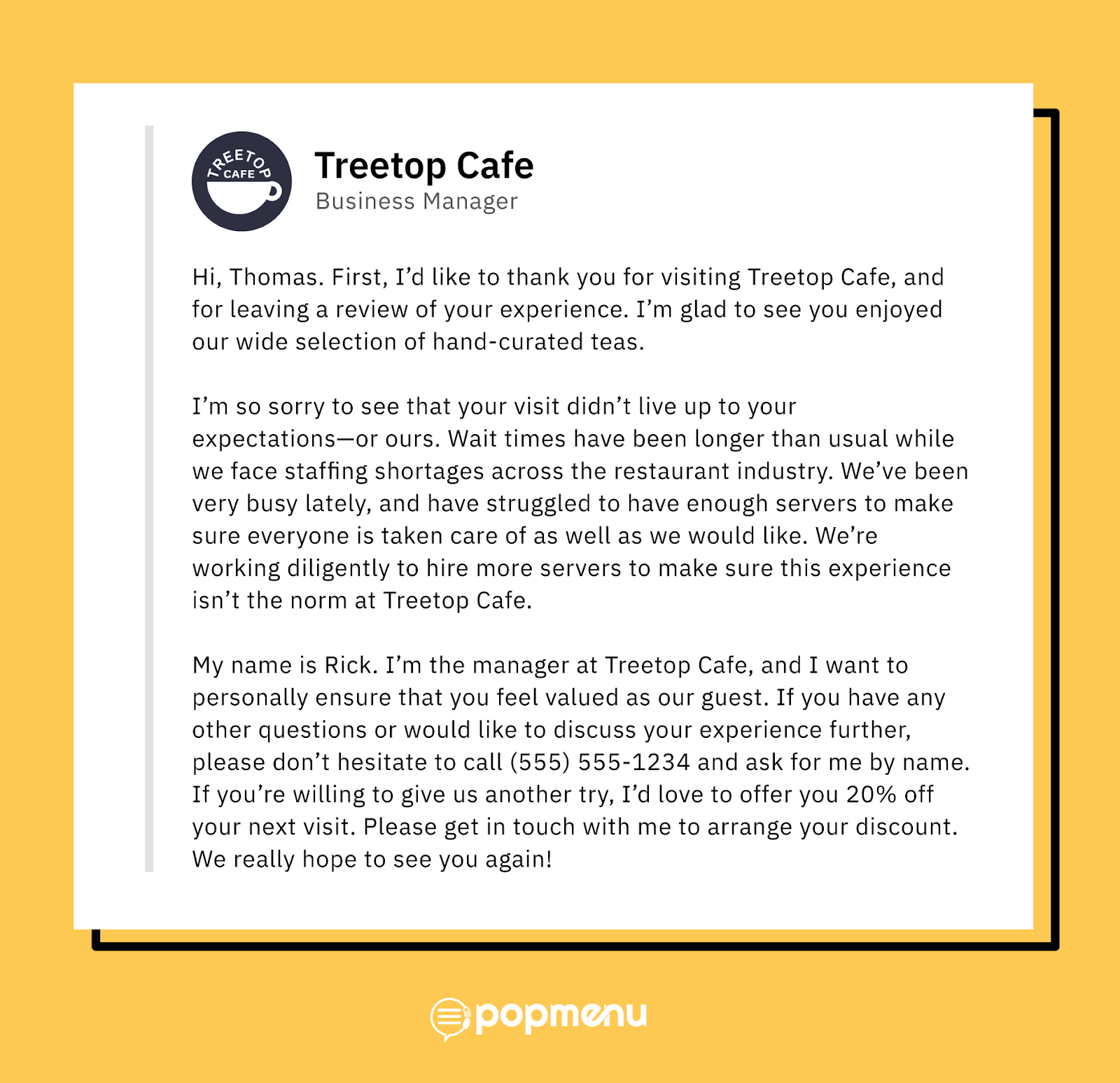
How to respond to bad restaurant reviews

Looking for something specific about restaurant reviews?
How should you handle bad restaurant reviews?
Template: Responding to bad restaurant reviews
How to avoid bad restaurant reviews?
When you get a bad restaurant review, your first instinct may be to panic—or to fight back. Take a breath because your response matters. Responding in the right way can defuse a bad review—or even encourage the guest who wrote it to give your restaurant another chance. But what’s even more important is that you can use a negative review to improve your restaurant in real, meaningful, and impactful ways.
When you get a bad review, it’s far from the end of the world. First, you need to respond to the review in a way that helps mitigate the customer’s bad experience. Then, you need to use that review to gather data on what your restaurant can do better—and how.
Here’s everything you need to know about responding to bad restaurant reviews the right way.
How Bad Reviews Can Affect Your Restaurant

Especially in the digital age, negative reviews can be extremely detrimental to your restaurant in a number of ways:
- Potential new customers might avoid your restaurant. Research has shown that just one negative review can cause as many as 22 percent of potential new customers to shy away from your restaurant. With three negative reviews, that goes up to 59 percent of potential new guests. Four negative reviews can drive away up to 70 percent of potential customers. This can be especially detrimental to a new restaurant. Businesses that receive a lot of negative reviews, especially early on, may not be able to recover unless they completely rebrand themselves—but even then, there’s no guarantee of overcoming that bad first impression.
- Revenue may decrease. Having many negative reviews can cost businesses—including restaurants—sales. An LSA Insider study showed that businesses with a star rating of 1-1.5 on popular review sites have 33 percent less revenue than average.
- Your SEO may be impacted. Customer reviews are one of many factors that Google takes into account when ranking search results. That means that if your restaurant has negative reviews, it may not show up at the top of the results for important search terms, which could prevent new guests from even being able to find your restaurant.
- Guests may question their trust and loyalty to your brand. An article by Forbes found that as many as 50 percent of customers question the quality of a business after reading negative reviews about it—even if they’ve had good experiences themselves.
How Should You Handle Bad Restaurant Reviews?
Ideally, your restaurant should respond to every online review it receives. But at the very least, always be sure to respond to negative reviews, following these best practices.
Best Practices for Responding to Bad Restaurant Reviews

Respond quickly.
As a restaurant owner or manager, you should be checking Yelp, Tripadvisor, social media, and other restaurant review sites very regularly to watch for bad reviews. When you see a negative review, it’s important to respond to it quickly (but not so quickly that you respond angrily or emotionally). Ideally, try to respond to a negative review within 2-3 days.
Be professional.
When you respond to a negative review, every second and every interaction counts as you try to rehab the guest’s bad impression of your restaurant. That’s why, when you respond, it’s essential to be professional—polite, friendly, and apologetic—and use proper grammar and punctuation in your response.
Don’t take the review personally.
Most of the time, a bad review reflects a guest’s dining experience at a restaurant. It’s not about you as a person (unless they had a terrible interaction with you while they were at the restaurant, but that may signify a bigger problem than bad reviews). It’s important to keep the bigger picture in mind, and don’t take bad reviews personally as a restaurateur.
Say “Thank you” and “Sorry”
No matter what else your review says, make sure to hit on the two most important points: Thank the guest for giving your restaurant a try, and apologize for what went wrong. We’ll go into more detail about how to write an effective response to a bad review later on in this article, but these are the two phrases to never be afraid of saying.
Be available to follow up
When you respond to negative feedback about your restaurant, it’s a great idea to provide contact information—including your name and phone number or email address—so the guest can follow up with you personally if they want more information.
Be personal
When you respond to a review, do it as yourself, not as your restaurant name. Instead of saying something like, “We at Mama G’s Homestyle Italian are sorry,” make it personal by saying, “My name is Geraldine and I’m the owner of Mama G’s Homestyle Italian. I want to personally apologize that our restaurant experience didn’t live up to your standards—or ours.”
Take responsibility
In the same vein, it’s important to recognize when your restaurant has let a guest down, and take responsibility for the failure. A good response to a bad review should be humble and apologetic. It should confront the problem head-on, not deflect responsibility or make excuses.
Don’t get defensive
Zero star Yelp reviews can feel unfair—more like takedowns than constructive criticism. But it’s important to keep in mind that a bad review isn't the New York Times restaurant review section—it's a real experience shared by your real restaurant guests. No matter how hurtful a bad review might be, don’t get defensive about it. Instead, stay humble and helpful, and keep your tone friendly as you work toward a resolution.
Invite guests back to try your restaurant again
And finally, when responding to a bad review, make sure to invite the guest back to give your restaurant another try (and consider offering them an incentive for doing so, like a discounted ticket or a free item). This is especially important as restaurants are still grappling with the effects of the pandemic, which has created a constant barrage of unexpected new challenges, from a huge increase in takeout and delivery to an unprecedented labor shortage.
Bad Restaurant Review Response Template
Not sure how to respond to a bad restaurant review? Let’s look at an example of a bad review, and the ideal way to respond to it, using six key steps.

- Thank the guest by their name. The guest who left the review should have a profile on the review site where you can see their name. Address them by name in a friendly manner, and thank them for visiting your restaurant and leaving you a review. Example: Hi, Thomas. First, I’d like to thank you for visiting Treetop Cafe, and for leaving a review of your experience.
- Highlight something positive. Point out some good feedback, or look for something the guest wrote that you can construe as positive. Example: I’m glad to see you enjoyed our wide selection of hand-curated teas.
- Apologize sincerely. Offer the guest a sincere apology for what went wrong. Example: I’m so sorry to see that your visit didn’t live up to your expectations—or ours.
- Explain what went wrong. Let the guest know what caused their bad experience to occur, and (this part is important) what you’re doing to ensure it won’t happen again. Example: Wait times have been longer than usual while we face staffing shortages across the restaurant industry. We’ve been very busy lately, and have struggled to have enough servers to make sure everyone is taken care of as well as we would like. We’re working diligently to hire more servers to make sure this experience isn’t the norm at Treetop Cafe.
- Offer to move the discussion offline. Give the guest your contact information and offer to speak with them personally if they’d like any more information. Example: My name is Rick. I’m the manager at Treetop Cafe, and I want to personally ensure that you feel valued as our guest. If you have any other questions or would like to discuss your experience further, please don’t hesitate to call (555) 555-1234 and ask for me by name.
- Invite the guest back. Don’t forget to give them a chance to come back and have a better experience. Example: If you’re willing to give us another try, I’d love to offer you 20% off your next visit. Please get in touch with me to arrange your discount. We really hope to see you again!
When you put all these pieces together, you get a response that looks like this:

How to Avoid Bad Restaurant Reviews in the Future
At the end of the day, you can’t guarantee that no guest will ever have a negative experience in your restaurant. You can do your best, but some things are just out of your control. What you can do? Avoid having bad reviews written in the first place. Here are a few strategies to use.
Make Positive Reviews More Accessible
By making it easier for new customers to find good reviews, you can prevent them from developing a bad impression of your restaurant before they even dine with you. By hosting reviews directly on your online menus, you can approve what gets published, respond privately to negative reviews, and showcase glowing reviews for other customers to see. To learn more about hosting reviews directy on your menu, check out Popmenu's dynamic menus.
Learn From Your Reviews
Many restaurateurs don’t recognize that low-star reviews can be a great tool.
These reviews are full of data about areas where your restaurant can improve. To find those, keep a close eye on your reviews and watch for trends—even in the positive reviews. Guests may mention even small things that need your attention, and improving them will likely turn into better reviews in the future.
Head Off Bad Reviews
It shouldn’t be a surprise when a guest has a bad experience. Restaurant staff should be paying attention to guests’ experiences and checking in throughout their visit. This way, if they notice that something has gone wrong or a guest isn’t fully satisfied, they can intervene—before the guest gets home and writes a bad review.
If you see something go wrong for a guest, check in with them personally and try to make it right. This can help avoid bad reviews before they even happen.
Encourage Good Reviews
On the other hand, if you see guests in your restaurants who are clearly having a good time, encourage them to leave you a review on one or more popular review sites. Soliciting positive reviews will boost your restaurant’s overall rating, and make bad reviews less impactful.
Bad Restaurant Reviews Don’t Have to Mean Disaster
Bad reviews are something no restaurant wants. But with the right strategy, you can reduce them—and mitigate their effects when they do happen.




.jpg)

.jpeg)





